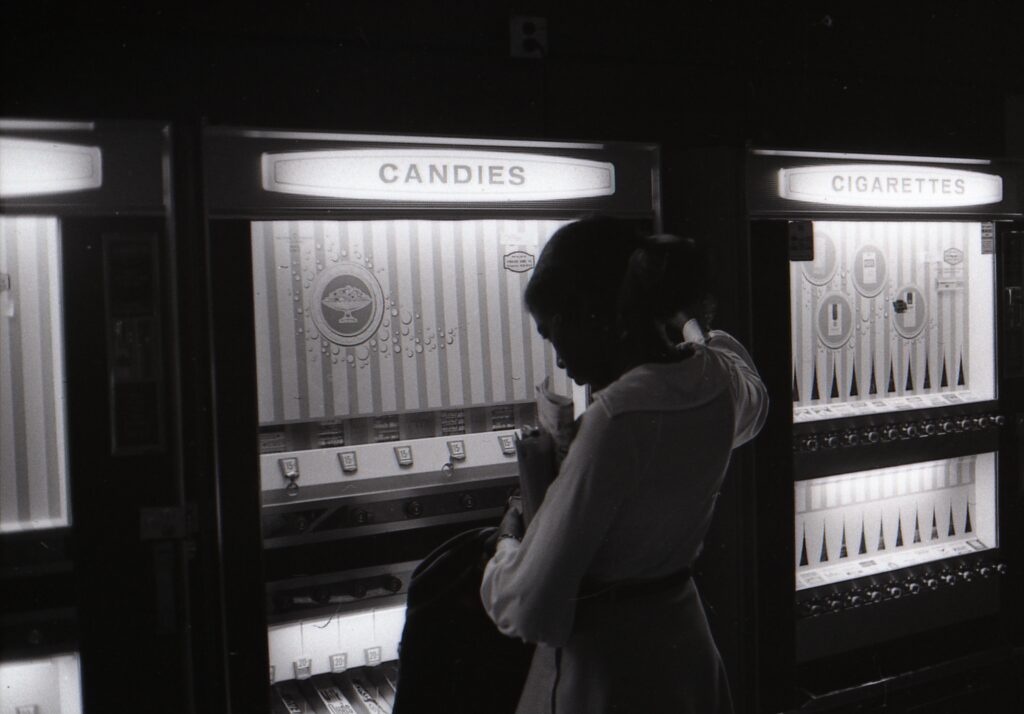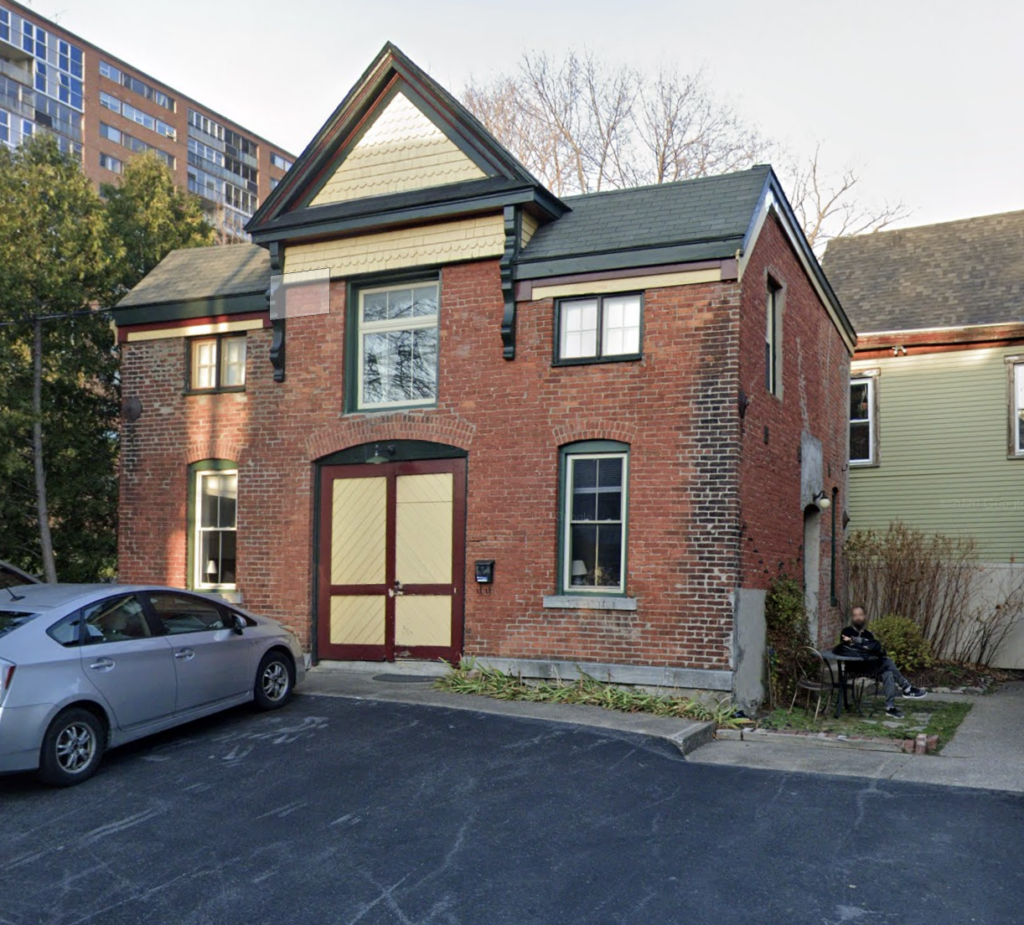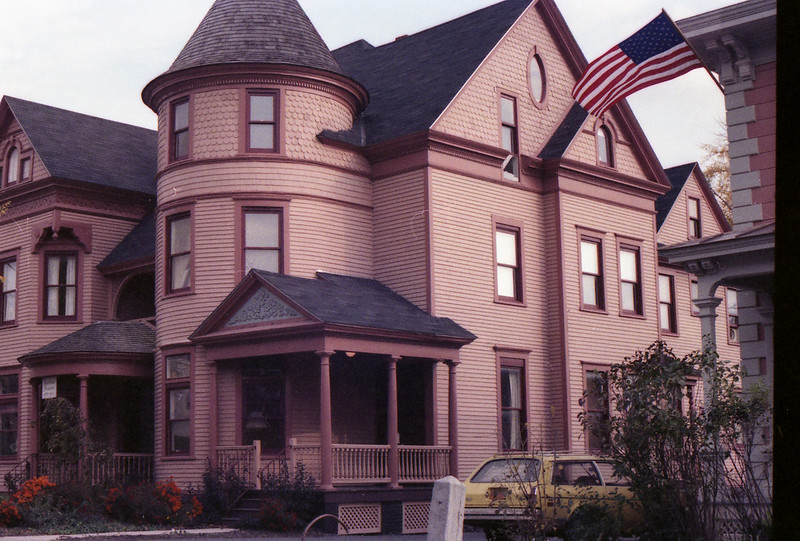Going Back, Again: The River
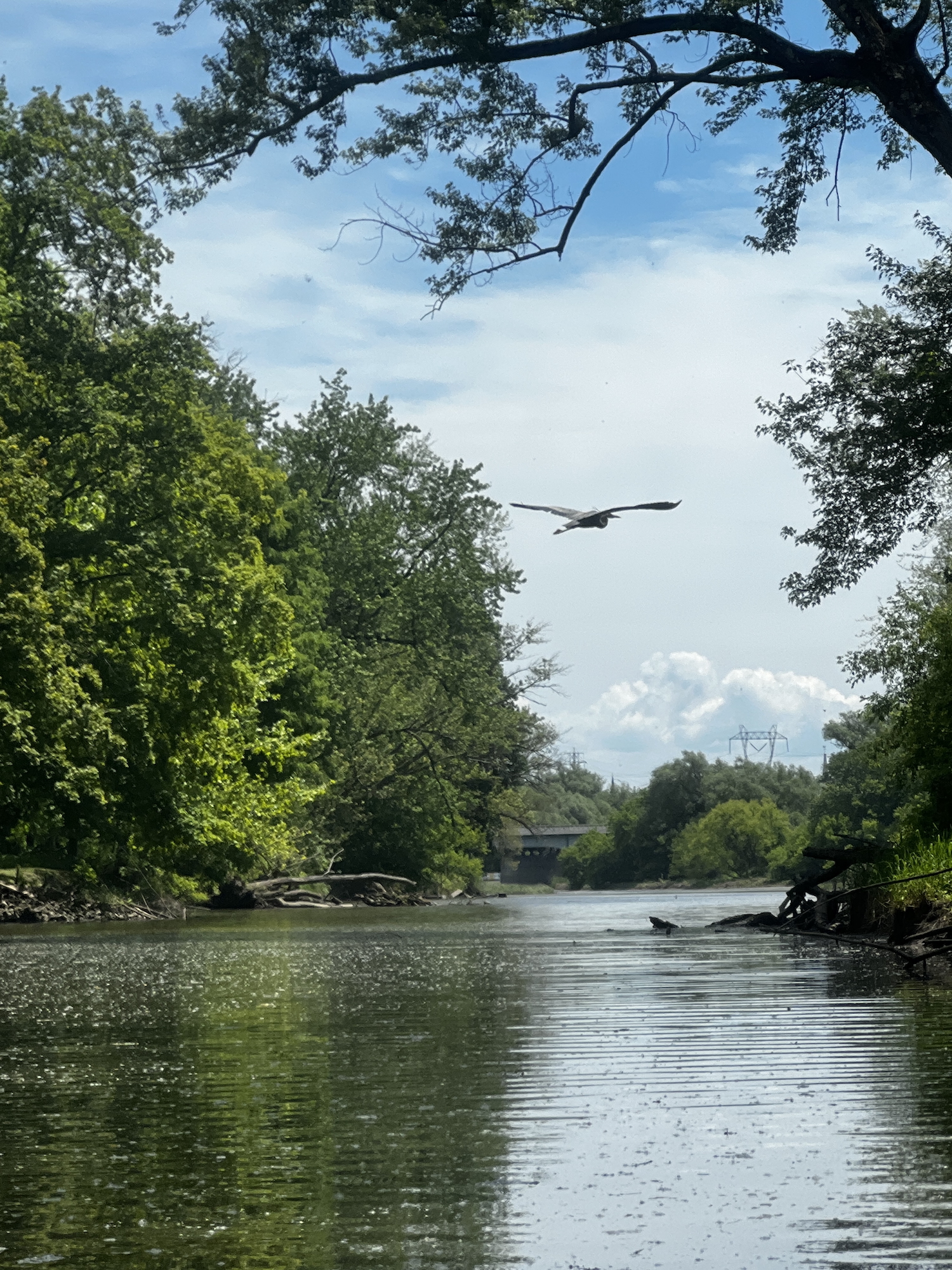
A couple of weeks back, WXPN put on a 24-hour songwriting challenge – something I signed up for because all the kids were doing it, and something I even thought I might attempt. Sign up, and on May 31, get a song prompt, and have 24 hours to complete the song and upload a recording. I’d have had no illusions about exposure or anything else; I just liked the challenge.
I didn’t end up participating, because the prompt opened up the day after we got back from vacation, I hadn’t touched an instrument in more than a week, and there were too many other things to get done in those 24 hours. Given the state of mind I was in, euphoric and rested, I would not have produced anything I liked anyway – ironic and unfortunate, because the prompt was “belong,” and I was just coming back from places where I very much belong.
That vacation was the most extended time we’ve spent around our old home towns in years – with no holiday events or weddings or graduations or any of those life events – just time to see a few people and be a few places. We lived most of our lives there, reared our children there, but now we’ve been away more than a decade, which is hard to believe. Our goals were primarily to bike some familiar routes and paddle some familiar waters.
We got to visit the Troy Farmers’ Market, where of course we still run into people we know. We got to hike Peebles Island, for the second time this year. I got to ride a section of the Mohawk-Hudson bike trail that I’ve ridden countless times going back to, I think, 1977. And we got to paddle a stretch of the Mohawk at Aqueduct and up the Alplaus creek, where early on our kids became accustomed to life in a canoe. All of that felt good and checked the emotional boxes I’d been hoping to check.
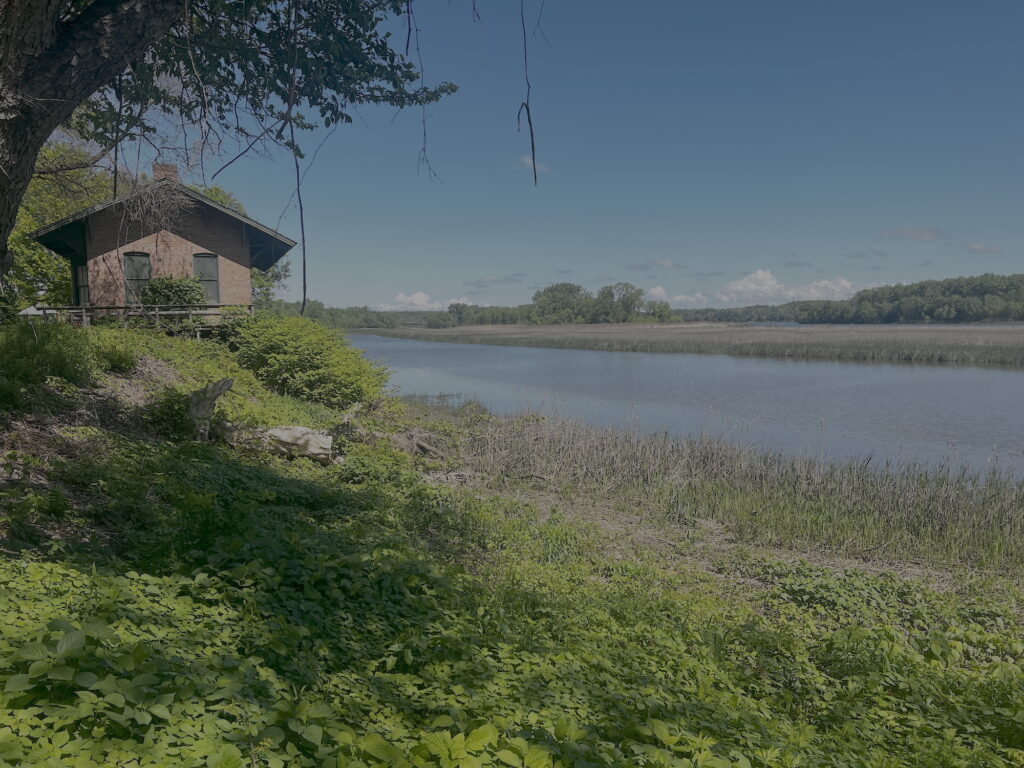
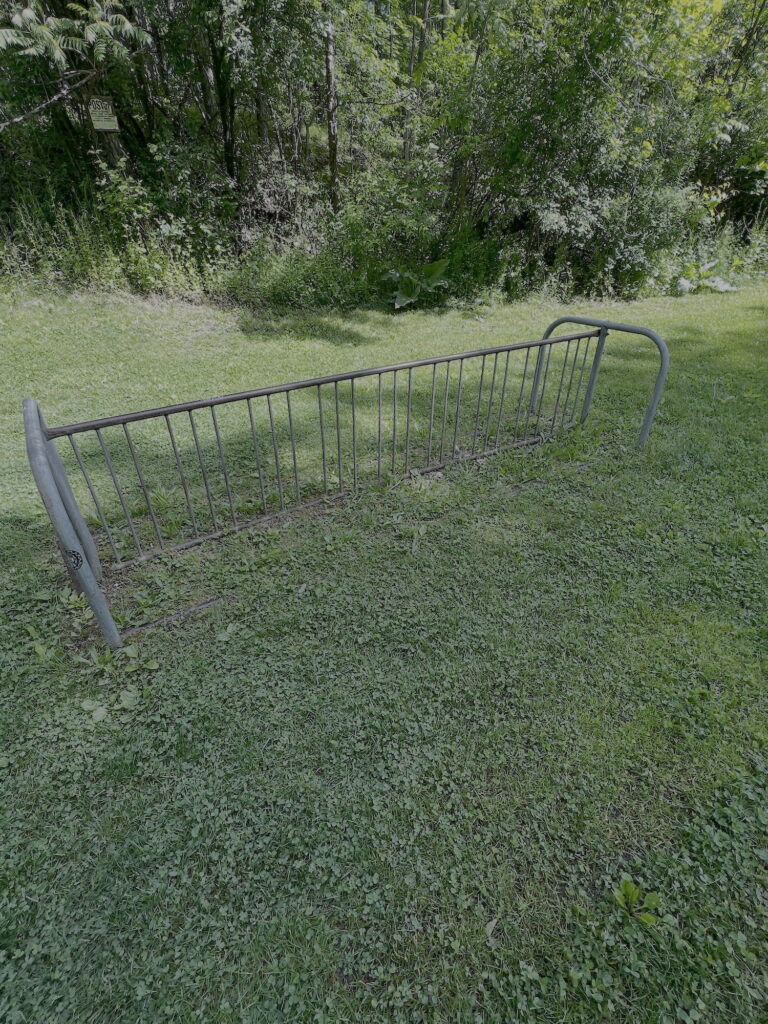

But the last day was the biggest, when I got to visit the water that pretty much defined me early on in my life. I can’t remember the last time I got to paddle this particular back channel of the Mohawk – a channel that runs along the bottom of the village where I grew up, just a block from our house. It’s been 12 years, anyway, which is far too long. Once I was there, I felt the passing of the decades, and in the same moment, like no time had passed at all.
We paddled in against a light current from the launch at Freemans Bridge, a trip of familiar landmarks – the railroad bridge that I once photographed as it was ablaze, the park I worked on building as a teenager, the legendary local drive-in restaurant that defines summer for many, and finally the “new” bridge that replaced the original Great Western Gateway Bridge just about 50 years ago.
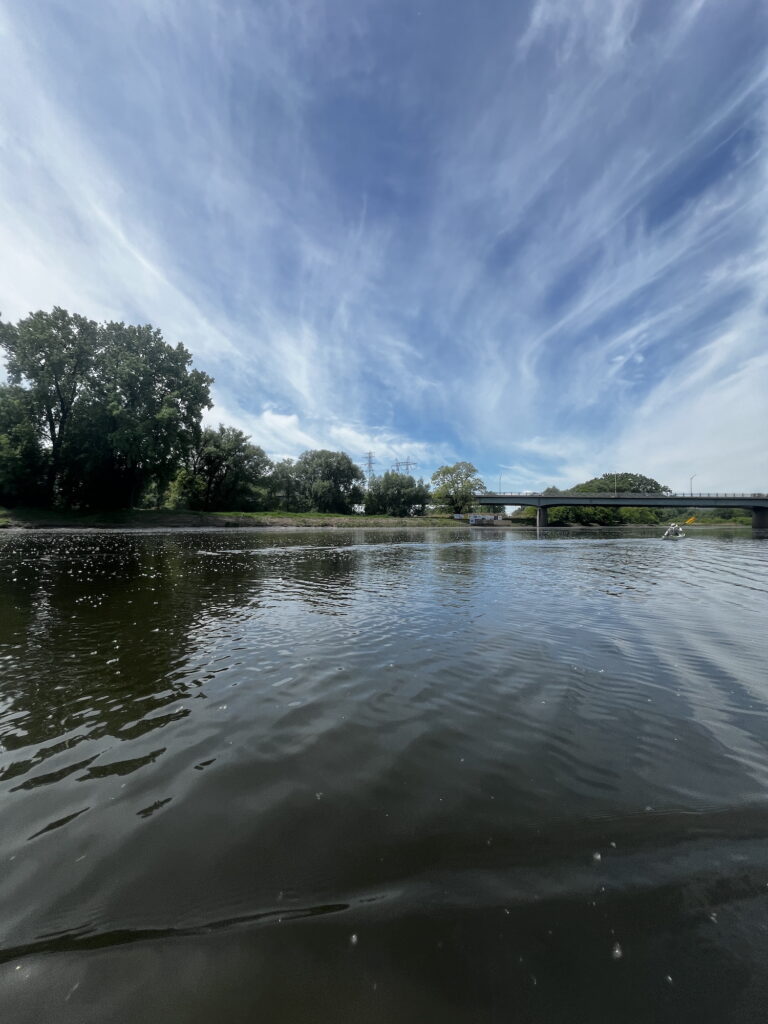
And then, rounding the corner by the Glen Sanders Mansion, we paddled into the channel that separates the mainland from what was called the Isle of the Mohawks. It was also once called Glenotia Island, home a century ago to a remarkable park with swimming, dancing and roller skating, that disappeared and left no traces decades before my group of teen friends romped all over the island in the 1970s.
The river, the channel, and the island make an outsized impression on my life – they were the locus of so much activity for perhaps six or seven years, which now seems so small in the scheme of things, but they were six or seven very important years. I think I was 10 when I met a family of boys who lived a few blocks away and owned access to the river – and perhaps 11 when the riverbank became the common center of our play. And I was probably about 16, a junior in high school, when I started to drift away to new friends and new interests, giving up the kind of play and adventures that marked those interceding years.
In those years, we had absolute dominion over that riverbank, which rises quite high from the water and is fairly steep in parts. For a long stretch, there are no homes directly abutting it, which meant all the noise we must have made was less noticeable (how teenage boys can holler!). In the spring, we would cut stairs from the dirt behind the garages, so we could more easily get up and down the bank. My friends had a big (somewhat leaky) wooden rowboat, and I remember the excitement when their father brought home a shiny new aluminum rowboat that we got to use. Eventually, there was an outboard motor (which had to be humped up and down those steps), but we mostly got around with oars. I learned to appreciate muscle power in those days.
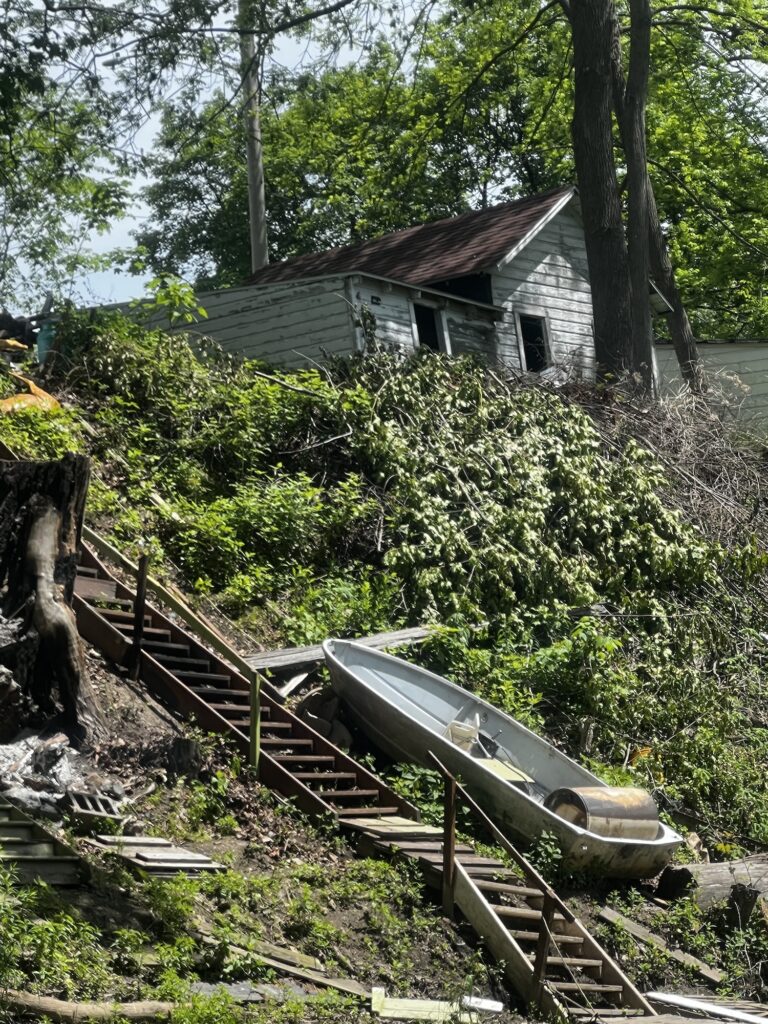
We ran up and down that riverbank, leaping across a gap by the sewer outfall to reach a stretch we called “The Flats,” where we climbed trees, swung from vines, invented all kinds of games. We rowed around the island (which is no longer separated from its neighboring island as it was when we were kids), out into the main channel – and if we had the motor, we’d go even further, downriver to Freemans Bridge or up to Lock 8. We fished a lot, from shore and from the boats. Despite the pollution, smallmouth bass were plentiful (and bullheads and the unwanted carp more so). We’d explore the other islands – which were largely untouched by human activity, other than electric transmission towers. (Once we found a stash of Civil Defense crackers in a cache on Big Island and cracked that open, so I can report that survivors of the nuclear apocalypse could look forward to a diet of bland soda crackers.)
It was the Isle of the Mohawks we made our own, using scythes, rakes and shovels to cut paths through the ever-present “itchy plant” (wood nettle) to clearings under the cottonwoods, where we’d play various chase games, shoot BB guns, and have riotous overnight camping trips.
The Mohawk was filthy at the time, and this channel received all kinds of raw sewage, so swimming wasn’t advised. Besides, it was shallow, muddy, and home to snapping turtles. Which isn’t to say we never swam there. Sometimes we’d take the motor out to a deeper, more flowing section of the main channel to swim.
In the winter, the channel would freeze and if the ice was good we’d skate and play hockey. There were years when the river would freeze very hard, sometimes to the bottom, and with the right conditions, we could skate very long distances on smooth, clear ice, cross-country skating of a type I’ve never been able to experience again. Other times, it would be more challenging, with solid center ice in the channel but soft or wet edges that we’d often break through. We were careful and mostly knew what we were doing, but that doesn’t mean there was never wetness and frostbite – just that no one ever fully fell in (that I recall) or got swept under. Sometimes we’d build fires on the island to get warm.
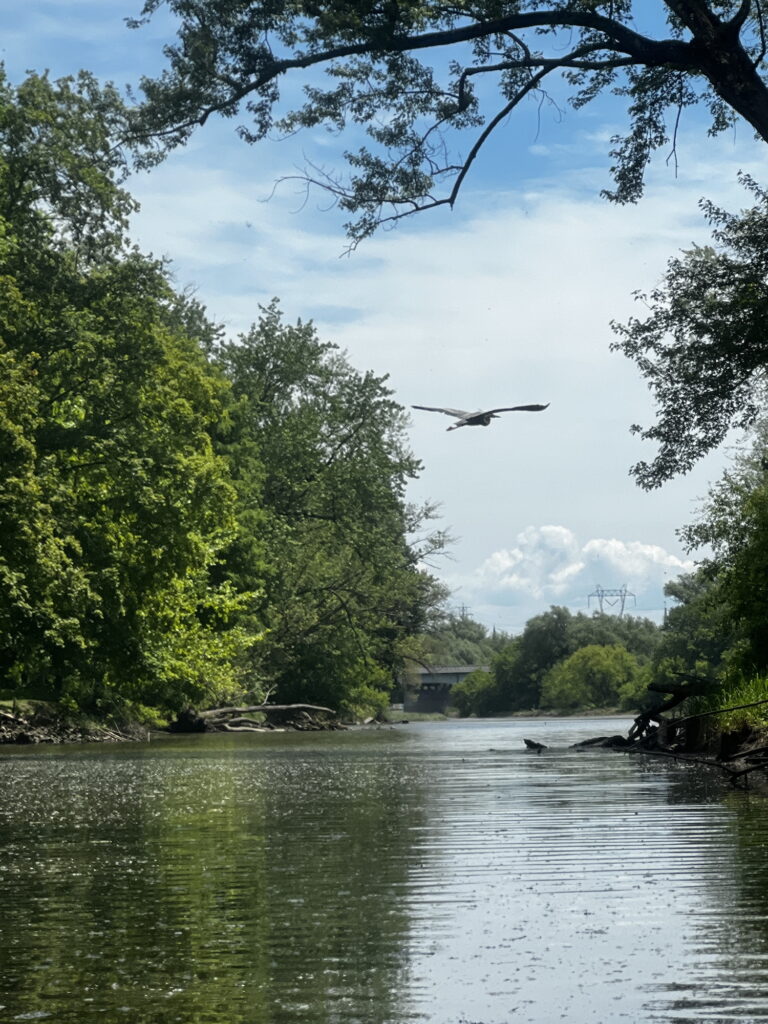
It was the 1970s, and, as I said, the river was not clean. There were fish and snapping turtles, but not much else. I have no memories of any geese, ducks or herons anywhere on that stretch of river (but there were frogs and massive raccoons, who excelled at removing the lids from the galvanized garbage cans of the day). The landscape was then what it is now – largely cottonwoods, huge vines, an abundance of wood nettle, lots of phlox and irises and, my absolute favorite come September, wild grapes. Less of the riverbank was tended than it is now, and there was more strewn trash, including detritus from a sign shop whose owner had once owned a key riverfront property. Now some of the flats is tended like a lawn, though it is still very much river’s edge.
As we paddled in, at first, an element of the experience was missing, but then as the breeze died and the sun strengthened, it very suddenly emerged – that distinctive river smell, the muddy scent of mucky wet land and water and vegetative rot. That was when I really started to feel at home.
We paddled in and I saw a place where once we built fires on the island in winter. We passed The Flats and the sewer outfall that marked the steeper part of the riverbank. I looked up at the garages of my friends’ house (and the neighboring garage we would sometimes leap to, roof to roof), the riverbank there long untended, the tree that once marked the boat landing long collapsed. (The neighboring lot seems to have an extensive set of steps and docks now.) We passed the two landing points we used to get on the island (and thanks to “itchy plant” and muck, had no desire to try landing ourselves).
Further in, we passed where the island was, even in our day, barely separated from a mainland farm by a seasonal ditch, and across from that, the place where a friend since kindergarten lived, high up on the riverbank – a friend who died before we were done playing those teenage games. We paddled further and further in, behind the houses near mine, and then down a bend in the channel that flowed down to that farmland before coming to an end, an end we couldn’t reach then or now because of giant fallen snags across the river.
On this return to a place where I once belonged, I was as present as I’d ever been, fully taking in the raw beauty of this largely wild landscape. This was the landscape that defined my aesthetic, after all, so of course I find it beautiful – beautiful in its ordinariness. It looks almost like any upstate scene, a glorious mix of grasses and trees, of wild flowers and edge plants, the scent of the muddy water, the narrow piercing blue sky. The songs of the cardinals, robins and redwings, the scolding scree of annoyed herons, the leaping of aggressive bass. Along with my wonderful partner – who has known me almost all the way back to those years, since I was not quite 18, and who knows what this place means to me – I was utterly there, and utterly then. All that history was with me, the shadows of my long-ago friends and all the fun we had there, as was the importance of this space that so long ago became a part of my identity. Here was a place where I found friends and friendship, and independence – and here was a place that represented not-home, away from whatever stress and chaos I was feeling within those walls. It was a place where I literally could not be found. And if we were out on the water, that was even more true – we were utterly free, for good and for bad. (Did we do things we should not have done? Absolutely.)
And now? That channel of the Mohawk is always within me, and every time I go out on the water, that’s the experience I’m looking for. Unfortunately, it’s a rare one, not so easy to replicate. This was where I learned to be on the water, where I learned to want to be on the water – this is the water that made me fall in love with water. And this is a place where I always belong.

